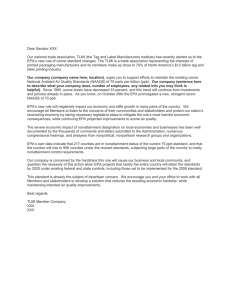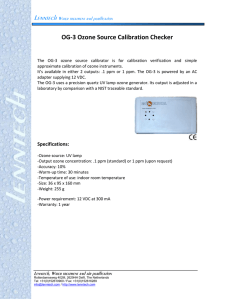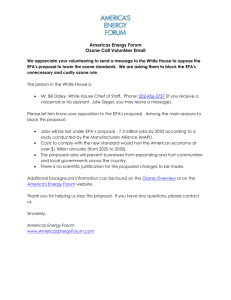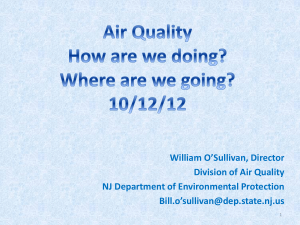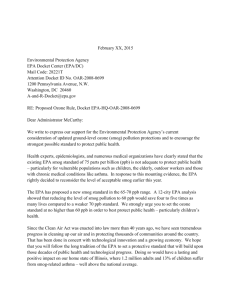The Clean Air Act, which was last amended in 1990,... Standards (40 CFR part 50) for pollutants considered harmful to...
advertisement
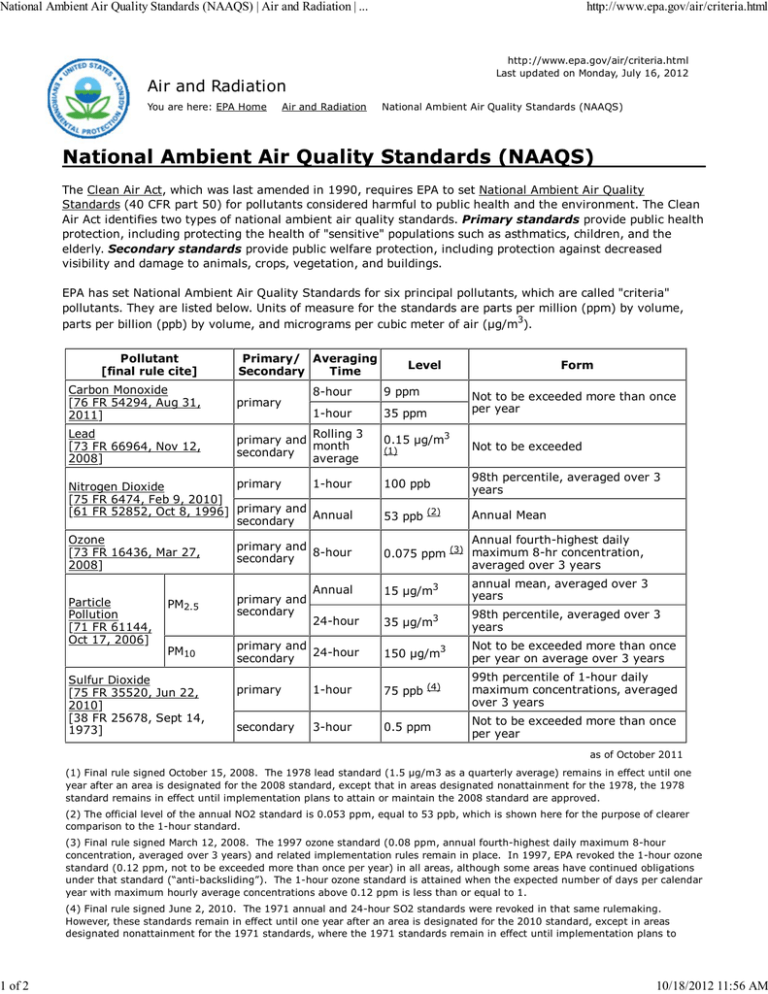
National Ambient Air Quality Standards (NAAQS) | Air and Radiation | ... 1 of 2 http://www.epa.gov/air/criteria.html http://www.epa.gov/air/criteria.html Last updated on Monday, July 16, 2012 Air and Radiation You are here: EPA Home Air and Radiation National Ambient Air Quality Standards (NAAQS) The Clean Air Act, which was last amended in 1990, requires EPA to set National Ambient Air Quality Standards (40 CFR part 50) for pollutants considered harmful to public health and the environment. The Clean Air Act identifies two types of national ambient air quality standards. Primary standards provide public health protection, including protecting the health of "sensitive" populations such as asthmatics, children, and the elderly. Secondary standards provide public welfare protection, including protection against decreased visibility and damage to animals, crops, vegetation, and buildings. EPA has set National Ambient Air Quality Standards for six principal pollutants, which are called "criteria" pollutants. They are listed below. Units of measure for the standards are parts per million (ppm) by volume, parts per billion (ppb) by volume, and micrograms per cubic meter of air (µg/m3). Pollutant [final rule cite] Primary/ Averaging Secondary Time Carbon Monoxide [76 FR 54294, Aug 31, 2011] primary Lead [73 FR 66964, Nov 12, 2008] Rolling 3 primary and month secondary average Level 8-hour 9 ppm 1-hour 35 ppm 0.15 μg/m3 (1) Form Not to be exceeded more than once per year Not to be exceeded primary 1-hour Nitrogen Dioxide [75 FR 6474, Feb 9, 2010] [61 FR 52852, Oct 8, 1996] primary and Annual secondary 100 ppb 98th percentile, averaged over 3 years 53 ppb (2) Annual Mean Ozone [73 FR 16436, Mar 27, 2008] Annual fourth-highest daily 0.075 ppm (3) maximum 8-hr concentration, averaged over 3 years Particle Pollution [71 FR 61144, Oct 17, 2006] PM2.5 PM10 Sulfur Dioxide [75 FR 35520, Jun 22, 2010] [38 FR 25678, Sept 14, 1973] primary and 8-hour secondary Annual 15 μg/m3 annual mean, averaged over 3 years 24-hour 35 μg/m3 98th percentile, averaged over 3 years primary and 24-hour secondary 150 μg/m3 Not to be exceeded more than once per year on average over 3 years primary 1-hour 75 ppb (4) 99th percentile of 1-hour daily maximum concentrations, averaged over 3 years secondary 3-hour 0.5 ppm Not to be exceeded more than once per year primary and secondary as of October 2011 (1) Final rule signed October 15, 2008. The 1978 lead standard (1.5 µg/m3 as a quarterly average) remains in effect until one year after an area is designated for the 2008 standard, except that in areas designated nonattainment for the 1978, the 1978 standard remains in effect until implementation plans to attain or maintain the 2008 standard are approved. (2) The official level of the annual NO2 standard is 0.053 ppm, equal to 53 ppb, which is shown here for the purpose of clearer comparison to the 1-hour standard. (3) Final rule signed March 12, 2008. The 1997 ozone standard (0.08 ppm, annual fourth-highest daily maximum 8-hour concentration, averaged over 3 years) and related implementation rules remain in place. In 1997, EPA revoked the 1-hour ozone standard (0.12 ppm, not to be exceeded more than once per year) in all areas, although some areas have continued obligations under that standard (“anti-backsliding”). The 1-hour ozone standard is attained when the expected number of days per calendar year with maximum hourly average concentrations above 0.12 ppm is less than or equal to 1. (4) Final rule signed June 2, 2010. The 1971 annual and 24-hour SO2 standards were revoked in that same rulemaking. However, these standards remain in effect until one year after an area is designated for the 2010 standard, except in areas designated nonattainment for the 1971 standards, where the 1971 standards remain in effect until implementation plans to 10/18/2012 11:56 AM National Ambient Air Quality Standards (NAAQS) | Air and Radiation | ... 2 of 2 http://www.epa.gov/air/criteria.html attain or maintain the 2010 standard are approved. See historical tables of NAAQS standards Carbon Monoxide Lead Nitrogen Dioxide Ozone Particle Pollution Sulfur Dioxide Menu of Control Measures for NAAQS Implementation The Menu of Control Measures (MCM) provides state, local and tribal air agencies with the existing emission reduction measures as well as relevant information concerning the efficiency and cost effectiveness of the measures. State, local and tribal agencies will be able to use this information in developing emission reduction strategies, plans and programs to assure they attain and maintain the National Ambient Air Quality Standards (NAAQS). The MCM is a living document that can be updated with newly available or more current data as it becomes available. Menu of Control Measures (PDF) (66pp, 999k) Menu of Control Measures (Excel) (480k) 10/18/2012 11:56 AM
